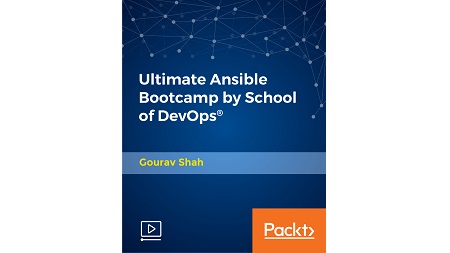
English | MP4 | AVC 1280×720 | AAC 44KHz 2ch | 7h 22m | 2.29 GB
The unofficial guide to becoming an EX407 Redhat certified specialist in Ansible automation
Ansible is set to be the standard in the world of IT infrastructure management. It’s a rare combination of simplicity meeting sophistication. Its core principle is simple is reflected in all its design choices such as an agentless setup, small footprint, push model, YAML as a language to define infrastructure state and so on. It’s easy to setup, easy to write code with, and easy to extend while writing custom modules. At the same time, it offers everything an IT system, networks or a operations/DevOps person needs. Once you set up the environment with the code spaces tool, you start diving into the simple and sophisticated world of Ansible one concept at a time. By the end of this course, you will have mastered Ansible and should be able to use it to automate servers, applications, and understand all the primitives that Ansible offers.
This course is been created to help you master Ansible one step at a time. It starts with the fundamental concepts related to infrastructure as code, what Ansible is, what is Idempotence, and what makes Ansible stand apart. Then it helps you relate Ansible to your project by taking up a use case.
What You Will Learn
- What is Ansible, why it’s needed and how it works?
- How to configure Ansible and setup static/dynamic inventories.
- Ad hoc server management, running jobs in parallel.
- Managing systems entities using Ansible modules.
- Writing playbooks to define the state of infrastructure as a code.
- Creating modular, reusable code with roles.
- Creating dynamic code with vars and templates.
- Using Ansible Galaxy.
- Encrypting sensitive data with Vault.
- Service discovery and managing multiple environments.
- Application deployment strategies, and rolling updates.
Table of Contents
01 The need for a Container Orchestration Engine
02 Battles of COEs, which one to choose
03 Key Features of a COE
04 What makes Kubernetes the de facto COE choice
05 Negatives of using Kubernetes
06 Section Intro – Path to Automation with Kubernetes
07 Namespaces
08 Pods
09 Replication Controller, Replica Sets and Deployments
10 Service Discovery and Load Balancing
11 Applying kubernetes primitives to your Application Stack
12 Configmaps and , Storage, Network, RBAC etc.
13 Daemonsets, Statefulsets, Crons and Jobs
14 Kubernetes Architecture Run Down
15 Building production grade Hight Available Kubernetes Cluster
16 Section Intro- Setting up Environment
17 Provisioning and configuring Digital Ocean Nodes
18 Initialise Cluster with Kubeadm
19 Setting up Weave CNI
20 Launching Kubernetes Dashboard
21 Setting up a kubernetes Visualizer
22 Resetting cluster created with kubeadm
23 Section Intro – Pods
24 Writing pod Specification
25 Launching and Operating Pods
26 Troubleshooting Pods Issues
27 Attaching a volume to a Pod
28 Launching Multi-Container Pods
29 Connecting to Individual Containers
30 Section Intro – Replication Controllers
31 Setting up namespace and switching context
32 Writing Replica Set Specification
33 Launching Replica Set and Fault Tolerance
34 Section intro – Services
35 Writing Service Specification
36 Exposting services outside the Cluster
37 Service Discovery
38 Section Intro – Deployments
39 Writing Deployment Specification
40 Rolling Out a Deployment
41 Update and Rollback
42 Rollbacks
43 Solution part I – Deploying a worker App
44 Solution part II – Deploying DB service
45 Solutions part III – Results App
46 Section intro – Coonfigmaps and Secrets
47 Creating Config Map for Vote app Options
48 Setting up Environment Specific Configs
49 Adding Configs from Files
50 Creating Secrets to Encrypt Database Credentials
51 Setting Environment vars using Secrets
52 Section Intro- Persistent Volumes
53 Setting up RBAC for NFS Provisioner
54 Setting up NFS provisioner with Statefulset
55 Creating storage class for NFS
56 Claiming a persistent volume and mounting it
57 Dynamically provisioning of persistent volumes
58 Section Intro- Release Strategies
59 Defining Recreate as a Release Strategy
60 Canary Releases
61 Blue Green Deployments
62 Pausing and fixing rollouts
63 Section Intro HPA
64 Setting up code monitoring with Metrics Server
65 Defining Resource Requests and Limits
66 Creating a Horizontal Pod Autoscaler
67 Writing load test Job definition
68 Laying a siege with loadtest jobs
69 Autoscaling in action with HPA
70 Section Intro Ingress
71 Ingress Controllers and Ingress
72 Choosing Traefik as a ingress controller and DaemonSet as a deployment type
73 Creating DaemonSet for Traefik
74 Writing Ingress definition for vote app with named based routing
75 Testing ingress and accessing the application
76 Annotations and setting up basic auth for vote app
77 Creating default network policy for instavote namespace
78 Exposing public facing apps and allowing inter namespace communication
Resolve the captcha to access the links!